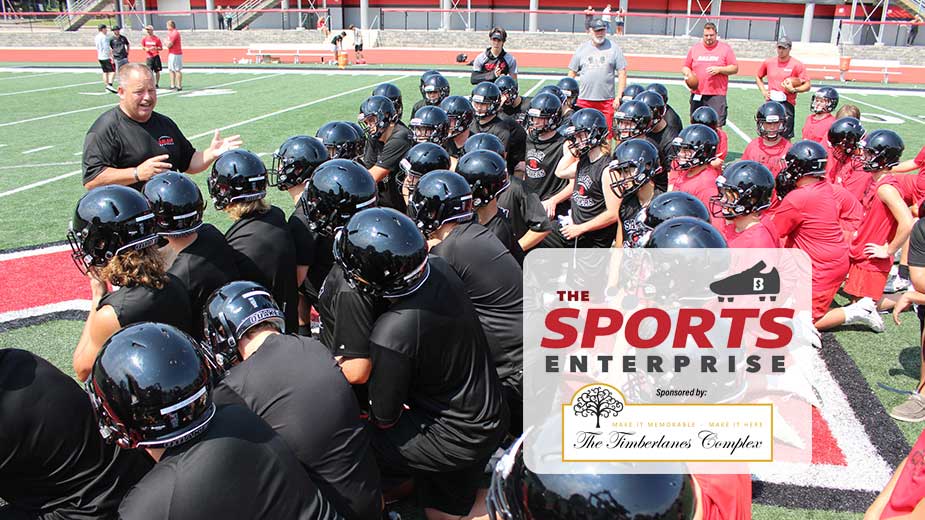Mahoning Valley High School Football Ready for Long Season
YOUNGSTOWN, Ohio – Heavy-breathing exhaustion compounded with aches and pains – nothing any high school football player wants to experience late in a game, let alone during a playoff run.
To avoid those kinds of problems in six months, teenagers are clanking weights in preparation for a 10-week regular and six-week postseason.
In addition to strength training, players do agility and movement drills to stay in shape, says Salem High School head football coach Ron Johnson.
“We’re a 365-day-a-year program,” he says. “Our guys stay in great shape. We’ve got a lot of multiple-sport athletes that work on that as well.”
The Ohio High School Athletic Association, the governing body for high school sports, expanded the postseason this year to accommodate twice as many teams in the playoffs. Last season, teams played a six-game regular season followed by a six-game postseason with all teams in the state qualifying, though they could opt out.
Before this season, the postseason was five weeks long. Football has divisions I to VII with I having the most-populated schools and VII containing the least. The playoff field expanded to 448 from 224 this season. A record 709 schools were eligible for the playoffs in 2020 because of the one-season rule change.
Doug Ute, executive director of the OHSAA, says he and the association’s board of directors heard from quite a few parents, players, coaches, school representatives and community members around the state about last year’s six-week postseason.
“It was great to get an opportunity to play in the playoffs,” Ute says.
The OHSAA sanctions 26 sports and the funds received from football helps to fund its other entities. In 2018, football had $1.9 million in expenses and $3.1 million in revenue. 2019 saw expenses of $1.9 million and revenue of $3 million. And 2020 had $1.9 million in expenses and $3.4 million in revenue.
As a former high school athletics director, principal and school superintendent, Ute is well aware of the athletics budgets in schools. The OHSAA receives its funding from its postseason tournament while its member schools have their coffers filled during regular-season games.
“Our revenue source provides more opportunities than just for the revenue-sports athletes,” he says. “They provide opportunities for all kids who want to participate.”
The extra game added to the postseason meant one week of preparation was taken away because the regular season began a week earlier than normal.
Springfield High School head coach Sean Guerriero, whose team played in the Division VI state title game the past two seasons, says it limits teams to two instead of three preseason scrimmages.
“You’re really limiting kids on reps and doing some things that I don’t think [the OHSAA] thought about,” he says. “I guess I’m more conscientious about that with our kids. How do we handle that? How do we make sure that we’re ready and the kids are safe and things of that nature?”
For teams to maintain peak performance during the regular season and beyond, teams have to find ways to prepare.
John F. Kennedy Catholic School, whose varsity football team advanced to the Division VII state championship game last year, had some hiccups along the way with preparation for this season.
The squad had to wait until almost the first of the year to start lifting as a team. Eagles coach Dom Prologo says Warren gym Global Fitness offered players discounted memberships since players couldn’t practice at school.
An assistant coach’s wife also teaches the team yoga to enhance their flexibility, training that has become part of its routine.
“Last year’s run and staying healthy all the way through the state championship – I think the yoga as well as our offseason conditioning was huge,” Prologo says.
Yoga is one aspect of the offseason and in-season regimen. It helps players to recover after a long week of preparation, says Eagles senior Eddie Kiernan. It also means he’s flexible enough to get into positions his opponents can’t.
“Being a lineman, flexibility is super, super important. It definitely goes a long way. It’s not common for football programs around here to
partake in yoga. But I think it’s helped us a lot,” says the 5-foot-11, 225-pound center. “It just helps that lactic acid get out a little bit. You feel a little better. That helps the flexibility, too.”
JFK had 90% of its 46 players take part in non-mandatory sessions of lifting, conditioning and yoga during June. The other 10% were on the school baseball team, which won the Division IV state title in mid-June.
“I’m fortunate to be at a school where the kids are locked in, bought in, and their parents are, too,” Prologo says.
And as the temperature peaks during the last weeks of summer training camp and the start of the season, the care players take of their bodies is paramount. Hydrating helps to overcome cramps during games.
Early on game mornings, Springfield senior Aaron Groner says his team checks in to make sure they are drinking enough liquids and they continue that routine throughout the day. He said Pedialyte also helps to alleviate the lack of hydration.
“[Guerriero] has us drink a lot of water here, probably like a gallon a day at practice,” Groner says.

Everybody trains and everybody plays hard but nobody rests hard is one of Dr. Christopher Liebig’s sayings. The director of sports medicine for Akron Children’s Hospital Mahoning Valley emphasizes that student-athletes should listen to their bodies and get the rest they need – eight to 10 hours of sleep.
Half of the injuries he sees in his office are the result of overuse in youth sports.
He sees a spike in football players from August through the OHSAA state championship game in early December.
Prevention begins with acclimatization before the official start date for practices on Aug. 1, something the governing state body has been preaching for the past couple of years.
There are more than 40 athletics trainers working with local high school programs.
As they work with local teams, they’re often emphasizing acclimatization, how to avoid heat illness and how to treat and prevent other ailments and injuries.
Hydration and stretching are not limited to just preparing for a game, Liebig says, but afterward “in an effort to prevent soreness and further injury down the line.”
Sleep and good nutrition are vital parts of a student-athlete’s well-being. “There’s a reason that all the major colleges are having sleep therapists come in as well as nutritionists,” he says. “There is something to all of that.”
Football is a demanding sport. Add the stress of schooling on top of those physical stressors and it can take a toll on a young athlete.
“Maybe the sleep takes a hit, just the excitement after Friday’s football game,” Liebig says.
“It’s hard to get that rest and you want to celebrate a big win, maybe. There’s a lot to that – getting the proper rest, letting the body reset, getting rehydrated and then just letting the body heal.”
Pictured at top: Salem High School head coach Ron Johnson talks to his team after a scrimmage against David Anderson High School July 23 at Sebo Stadium in Salem. Salem is one of many Ohio teams preparing for a season that could be up to 16 games for those who make the state championship contest.
Copyright 2024 The Business Journal, Youngstown, Ohio.



